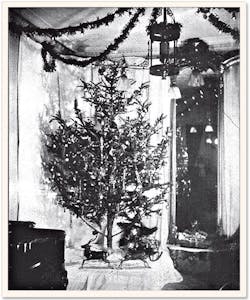How Edward Johnson Ushered in the Era of Christmas Tree Lights
What you’ll learn:
- How the first Christmas tree lights were designed and utilized.
- Learn about the technology involved in creating the display.
- How a campaign brought Christmas tree lighting to the masses.
It had only been three years since Edison invented the electric lightbulb when William Croffut, a reporter for Detroit Post and Tribune, decided to go for a stroll down East 36 Street in New York City on a cold December evening. A short time later, William set his eyes on a magical sight—a Christmas tree adorned with red, white, and blue lights the size of walnuts! The 6-foot tree was revolving around on top of a motorized wooden box in the parlor of Edward Johnson’s home.
“Last evening, I walked over beyond Fifth Avenue and called at the residence of Edward H. Johnson, vice president of Edison's electric company. There, at the rear of the beautiful parlors, was a large Christmas tree, presenting a most picturesque and uncanny aspect. It was brilliantly lighted with many colored globes about as large as an English walnut and was turning some six times a minute on a little pine box,” stated Croffut in an article describing the event.
“There were eighty lights in all encased in these dainty glass eggs and about equally divided between white, red, and blue. As the tree turned, the colors alternated, all the lamps going out and being relit at every revolution. The result was a continuous twinkling of dancing colors, red, white, and blue, all evening.”
Edward Johnson and Thomas Edison
Before he had the idea to adorn his Christmas tree with lights, Johnson worked as a telegraph operator, where he learned a great deal about how the system worked, piquing his interest in inventions and technology. Shortly after, he took part in helping to construct railways in Kansas and Denver while learning under the tutelage of William Palmer, a construction manager for the Kansas Pacific Railroad.
>>Check out this Series Library of similar electronics history-related articles
By 1871, Johnson headed back east to manage the Automatic Telegraph Company, where he met a young Thomas Edison, who he hired shortly after. Johnson eventually became a prominent supporter of Edison, aiding him with many of his inventions and even helping Edison establish his lab. Johnson spent three years in Europe representing Edison’s ideas and inventions before becoming the Vice President of the Edison Electric Light Company in 1882.
The Genesis of Christmas Tree Lights
It was during his time as VP when Johnson had the Christmas tree lights made as a one-off to demonstrate the capabilities the company could offer. The six sets of lights were hand-wired with 80 red, white, and blue lightbulbs, which were wrapped around a 6-foot tree. The tree itself was placed on top of a small wooden box that revolved using a tiny Edison dynamo at its base. The base was connected to a much larger dynamo in Johnson’s basement.
According to Croffut, the tree rotated around six times a minute, illuminating one set of lights at a time when facing the front of the parlor. This was accomplished using a “simple device of breaking and making a connection through copper bands faceted around the tree with corresponding buttons, turning each set on and off as they turned.”
The amazing part is that by utilizing the simple copper band method of making an electrical connection, they were able to create multiple different lighting effects using different combinations. What’s more, inside the same parlor, Johnson created a simulated colored fire inside his fireplace using paper and hidden lights, adding to the magic. While Edison was responsible for designing strand lights, it was Johnson who used them as a novel replacement to candles, which adorned Christmas trees before homes were outfitted with electricity.
Tree Lights’ Path to Mass Production
All of this was done at a time when most homes were still without power, as electricity was still considered dangerous by the public, along with the fact that outfitting homes with lights was an expensive prospect. Tree lights alone in 1900 could cost upwards of $300 (or $2,000 in today’s market), making them unaffordable for most people (Fig. 1).
Still, they were less hazardous than the candles people typically adorned their trees with during that time, which were responsible for many house fires during the holiday season.
Suffice it to say, Johnson’s lights were a hit, and the Edison General Electric Company was the first to mass-produce Christmas tree lights in 1901. They were offered in sets of nine carbon filament strings and targeted at businesses who wanted to draw attention to their storefront windows (Fig. 2).
It wasn’t until 1917 when Albert Sadacca, the son of parents who owned a novel lighting company, campaigned to popularize tree lighting. His campaign was successful, and the company released its first battery-powered set shortly afterward. From that point on, electric lighting for trees grew in popularity and has evolved into the smart lighting that’s available on the market today.
>>Check out this Series Library of similar electronics history-related articles
About the Author
Cabe Atwell
Technology Editor, Electronic Design
Cabe is a Technology Editor for Electronic Design.
Engineer, Machinist, Maker, Writer. A graduate Electrical Engineer actively plying his expertise in the industry and at his company, Gunhead. When not designing/building, he creates a steady torrent of projects and content in the media world. Many of his projects and articles are online at element14 & SolidSmack, industry-focused work at EETimes & EDN, and offbeat articles at Make Magazine. Currently, you can find him hosting webinars and contributing to Electronic Design and Machine Design.
Cabe is an electrical engineer, design consultant and author with 25 years’ experience. His most recent book is “Essential 555 IC: Design, Configure, and Create Clever Circuits”
Cabe writes the Engineering on Friday blog on Electronic Design.




